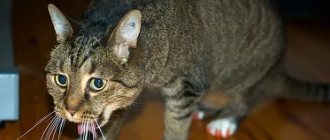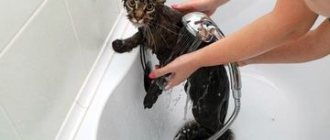Ever since a furry pet appeared in your home, noise, din and a cheerful mood have settled in it thoroughly. Joy and happiness grows in direct proportion to the fluffy ball, which responds to the nickname Vaska.
However, along with these positive emotions comes the realization that the little life and well-being of your beloved kitten is your responsibility. Therefore, in addition to your family physician, you should have a family veterinarian, who your pet needs just as much as you need your specialist.
We decide with a veterinarian
Today, you have the right to choose whether it will be a veterinarian at home or a visit to the hospital. In any case, the veterinarian is the second person after the owner who plays the most important role in the life of the pet. Therefore, you need to choose him extremely carefully and carefully, since all the basic recommendations on nutrition, health and quality care will come from him. He must be quite competent in this area, have experience in communicating with our smaller brothers, and find a common language with them quickly and effectively.
Going to the veterinarian: how to prepare
Two people should come to see the veterinarian: the pet and its owner.
Moreover, the most active role belongs to the owner. If you can't tell us anything about your pet's condition or can't hold him down to take his temperature or give him a shot, the visit may not be worth it. A cat or dog will not take itself to the doctor, so take matters into your own hands. This is how you need to prepare in order to benefit from a visit to the veterinarian.
Collect documents
When visiting a veterinarian, be sure to take your passport and the animal’s passport, which contains information about vaccinations and their schedule, and the names of medications. If your pet does not have documents, you can obtain a veterinary passport at our veterinary clinic.
Take a leash and muzzle
Aggression is a natural reaction of animals to an unfamiliar environment and unfamiliar animals nearby. Not all dogs and cats enjoy going to the clinic, so bring a muzzle for your dog and a carrier for your cat. A frightened cat without a special carrier can severely scratch its owner and run away. The dog must be kept on a leash. Remember, veterinarians, although they can communicate with animals, are not trainers.
Prepare your answers
Since animals cannot answer the questions the doctor is interested in, you will have to give the answers to them. If you're taking a pet you don't know well, such as your grandma's cat, to the vet, talk to the owner in detail first. Here is a list of questions that the veterinarian almost always asks:
- What's troubling?
- Has your pet's behavior and mood changed?
- When and how did the problems begin, what were the symptoms (signs of illness)?
- How has your appetite changed?
- Is there vomiting or diarrhea?
- What do you feed your pet every day?
- Has your pet eaten anything harmful recently?
- Is the vaccination and anthelmintic schedule adhered to?
- Does your pet have allergies?
- Is there discharge from the eyes, nose or genitals?
- How does the painful state change? (constantly bad, sometimes better, sometimes worse)
- What medications have you already given?
- What medications does your pet take on a regular basis?
Don't hide your problems
Many owners wash their pet or wipe off any discharge before visiting the veterinarian. This is strictly forbidden. If your pet has scabs on his skin, do not paint them with brilliant green. If your pet has discharge from the eyes, do not wash them before your visit. If you go to a dermatologist, do not shampoo your pet because the doctor will not be able to assess the condition of the skin.
When do we go to the vet?
If your furball behaves well, is quite active and voracious, then you shouldn’t bother him with visits to the doctor for up to two months. However, from the two-month period, vaccination begins, which requires a scrupulous approach. Therefore, 14 days before the expected date of vaccination, it is imperative to take the kitten for a general examination.
A qualified specialist must carefully examine your pet and make a professional verdict on the advisability of vaccinations. The general condition of the kitten must be consistently excellent, all medical nuances are taken into account and taken into account.
Your veterinarian should develop a further visit schedule based on the vaccination schedule. Of course, an unforeseen visit may happen if your pet gets sick or loses its appetite or becomes depressed. However, the doctor can prescribe preventive medications or procedures that quickly bring it back to normal.
Mandatory veterinary procedures for kittens in the first year of life
In the first year of a kitten’s life, its owner will have to take very careful care of his little pet in order to protect him from dangerous diseases and strengthen the baby’s immunity as much as possible. However, not all kitten owners know how to properly care for them and do not know all the nuances of raising them. In this article we will try to describe all the necessary procedures for caring for kittens.
So, you bought a kitten. Along with thoughts about what to feed, where to keep him, where to go to the toilet and, of course, how and what to play with, you have questions: what needs to be done to control and maintain health? And is there anything that needs to be done? Yes need.
First of all, inspect the kitten upon purchase. Carefully and slowly. First, the external structure of the body and head - are there any visible defects in the structure of the paws, tail and spine. Pay attention to the coat (in long-, medium- and short-haired breeds) - whether there are areas of alopecia (without hair) or on the skin of hairless breeds. Then you should examine your eyes to see if there are any discharges in them, if they are shiny or clear. It is also important to check the ears to see if there are visible black or brown crusts in the external auditory canal, examine the nose and oral cavity to make sure that there are no discharges from the nasal passages, no local areas of redness on the mucous membrane of the nose and mouth, ulcers on the gums and tongue.
At home, you can also measure your kitten's temperature. In the rectum, insert the thermometer 0.5 cm, after lubricating the tip with Vaseline oil. The temperature should be from 38.0 to 39.0. If after your examination you do not find anything alarming, congratulations - your animal is clinically healthy!
But, if, when purchasing an animal, you still doubt its complete health, then you should take the baby for examination to a doctor at a veterinary clinic or call a specialist at home. The sooner the symptoms of the disease are identified and treatment is prescribed, the greater the chances of a speedy recovery. In addition to proper feeding and care of the animal, it is necessary to carry out some mandatory activities in the first year of a kitten’s life.
Preventive vaccinations
Currently, most of the vaccines produced are polyvalent, i.e. One dose of the vaccine contains antigens from several diseases. The list of diseases against which compulsory immunization is performed is similar in different vaccines. This is, first of all:
- panleukopenia is a viral disease with a high mortality rate;
- calicivirus;
- rhinotracheitis is a disease characterized by a long stay of the virus in the body after illness;
- rabies is a fatal viral disease dangerous to animals and humans.
There are also vaccines against chlamydia, a chronic bacterial disease that affects humans, feline leukemia virus, an immunodeficiency disease that cannot be cured, and dermatophytoses, fungal skin diseases.
Kittens begin to be vaccinated at two to three months of age. The main condition for vaccination is that the animal must be clinically healthy before vaccination!
This means that the kitten must eat well, go to the toilet regularly and efficiently, be cheerful, alert and active.
7-10 days before the intended vaccination, preventive deworming is carried out (driving out worms). The kitten is given an anthelmintic veterinary drug (one dose) in the form of a tablet or suspension in a dose calculated depending on the animal’s body weight. After a prophylactic treatment of worms, no worms should appear in the animal’s feces! If they appear, it means that the animal has a helminthic disease, is not clinically healthy and cannot be vaccinated until it is completely free of parasites. In this case, the treatment regimen consists of re-administering antihelminthic drugs after 10 days. If necessary, treatment is carried out three times.
In order to vaccinate a truly healthy pet, kittens should not be taken for vaccination immediately after purchase, or after moving to a new place of residence, after hypothermia or overheating, or any other event that is accompanied by stress in the animal and weakens its immune system. Failure to comply with these conditions may negate the effectiveness of the vaccination - antibodies will not be produced or will be produced in small quantities.
The vaccination schedule in the first year of a kitten’s life is the same for most vaccines. The first vaccination is at 2-3 months of age against panleukopenia, calicivirosis, rhinotracheitis (some vaccines have an added component against chlamydia), the second - after 21-28 days (strictly!) with the same components as the first time, the third - a year with the same same components plus against rabies.
Repeated vaccination is possible in the period from 3 months to a year, depending on the vaccine manufacturer or living conditions (kennels, planned transportation of the animal to another city, country).
Vaccination is performed by a veterinary specialist after a preventive examination of the animal, thermometry and collection of information about the animal: age, when and where the animal was purchased, the state of appetite, activity of the animal, feces and urination, whether any therapeutic measures were carried out, whether treatment with hyperimmune serums was carried out, globulins and/or immunostimulants, whether preventive deworming was carried out.
After the direct injection, the animal is under the supervision of a doctor for 15-20 minutes to exclude possible allergic reactions to the components of the serum. Information about the owner and the animal is entered into a special vaccination log, and information about the vaccine is entered into the animal’s veterinary passport, which can be issued at the first visit to the doctor. After the first vaccination, the kitten may experience decreased activity and drowsiness on the first day; after subsequent vaccinations there should be no deviations in behavior.
Call a veterinarian to your home.
Antiparasitic treatments
As already mentioned, a week before the first vaccination, a preventive treatment of worms should be carried out using one of the veterinary drugs. This procedure should be repeated monthly until the kitten reaches six months of age. In six-month-old kittens, as well as in adult animals, this prophylaxis is carried out twice a year, usually in spring and autumn. Frequent preventative treatments before 6 months of age are associated with increased susceptibility of small kittens to invasive diseases (worms).
Another common antiparasitic treatment is to prevent the appearance of ectoparasites (fleas, lice, lice, scabies mites). For this purpose, there is a wide range of different preparations in the form of drops on the withers, sprays, powders. However, it is not advisable to use them on kittens under 3 months of age. Most drops on the withers provide protection against parasites for 1-1.5 months. If a kitten under the age of 3 months is found to have fleas or other ectoparasites during a routine examination, it is recommended to use special antiparasitic shampoos or short-acting medications.
In addition to the fact that fleas cause itching, irritation and local inflammatory reactions of the skin, they are also intermediate hosts for some types of helminths. Therefore, their removal and preventive measures must be carried out simultaneously.
One of the most common parasitic diseases in kittens is otodectosis - ear scabies. This disease is usually contracted at an early age from a mother cat or from other animals. If, during a preventive examination, black or brown crusts are visible in the kitten’s ears, the doctor, after performing a microscopy (scraping), refutes or confirms the presence of otodectosis and prescribes appropriate treatment, which consists of daily cleaning of the ears, external auditory canals and periodic application of anti-mite medications to the ears.
Hygienic treatments
Remember that when keeping a cat under normal conditions, you should try to bathe and wash it as little as possible! These are very clean animals and in most cases they do an excellent job of maintaining their hygiene themselves. In addition, frequent washing can provoke various irritations of the delicate skin of cats, as this is due to the structural features of the cat’s skin and the small number of sebaceous glands. Therefore, when purchasing a kitten, examine it, and if it is not very dirty and parasites are not found on it, you should not bathe it.
It is entirely acceptable to periodically wipe the fur with special sanitary napkins for animals. In some cases, trimming a kitten's claws is practiced. Usually it starts at 3-4 months. However, the best option would be to install a scratching post and teach your baby to use it. This will allow the owner to avoid trimming the adult cat's nails and therefore not subjecting it to unnecessary stress.
Sometimes, due to a genetic predisposition or metabolic disorder, cats need to have their anal glands cleaned. However, disturbances in their secretion at an early age are quite rare. Cleaning of kittens' anal glands is carried out as necessary during a routine examination by a veterinarian.
Castration and sterilization
If you do not plan to engage in selection and breeding, it is strongly recommended that your kitten be spayed or neutered between the ages of 7 months and one year. The best period for surgery is the end of active physical development and the beginning of puberty. This period varies depending on the breed and constitution of the kitten.
Contraindications to castration and sterilization may be general restrictions when using anesthesia - heart defects, kidney disease, increased allergic sensitivity to the components of medications.
In addition, an adult animal must be shown to a veterinarian once a year for a preventive examination and annual vaccination. Twice a year, worming is carried out. It is advisable for cats and female cats after the age of three to have a urine test to monitor and prevent urolithiasis. The analysis is done once a year. Let your kitten be cheerful and healthy!!!
Calling a veterinarian to your home
When a veterinarian comes to your house , you take the cat out of its hiding place and present it to the veterinarian for examination or some kind of medical manipulation, which is not always pleasant and sometimes painful.
The animal is not only outraged by such a familiar attitude towards it, it is also frightened by the fact that this is happening on its territory, where the animal previously felt safe; after the doctor leaves, the animal experiences severe stress, because... his home is not safe and such an attack could happen again.
In addition, the veterinarian’s on-call capabilities are very limited; the veterinarian can prescribe and give injections, take blood tests, but special studies such as x-rays, ultrasound, or surgery, the animal will have to be taken to the clinic.










